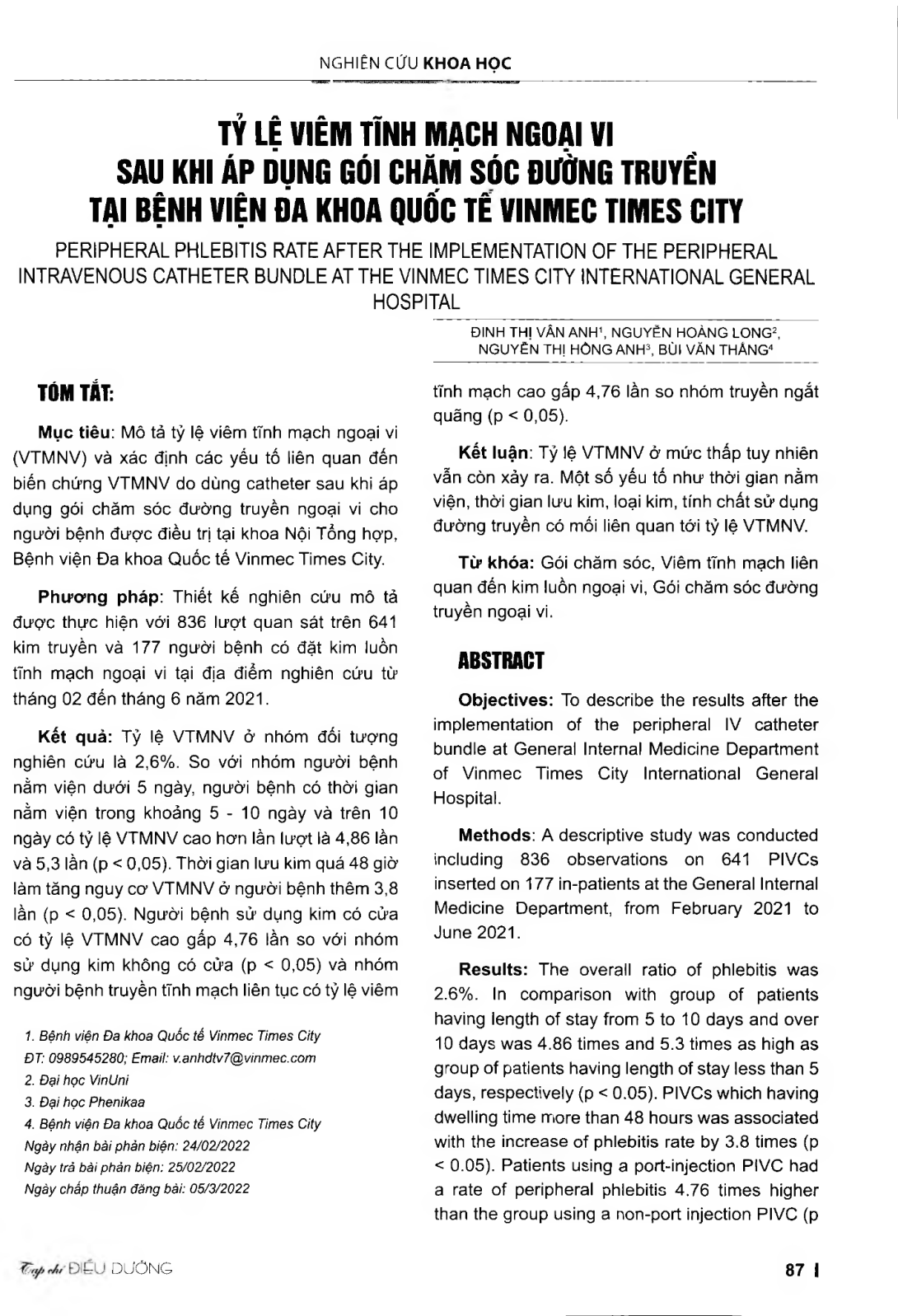
Mô tả tỷ lệ viêm tĩnh mạch ngoại vi (VTMNV) và xác định các yếu tố liên quan đến biến chứng VTMNV do dùng catheter sau khi áp dụng gói chăm sóc đường truyền ngoại vi cho người bệnh được điều trị tại khoa Nội Tổng hợp, Bệnh viện Đa khoa Quốc tế Vinmec Times City. Phương pháp: Thiết kế nghiên cứu mô tả được thực hiện với 836 lượt quan sát trên 641 kim truyền và 177 người bệnh có đặt kim luồn tĩnh mạch ngoại vi tại địa điểm nghiên cứu từ tháng 02 đến tháng 6 năm 2021. Kết quả: Tỷ lệ VTMNV ở nhóm đối tượng nghiên cứu là 2,6%. So với nhóm người bệnh nằm viện dưới 5 ngày, người bệnh có thời gian nằm viện trong khoảng 5-10 ngày và trên 10 ngày có tỷ lệ VTMNV cao hơn lần lượt là 4,86 lần và 5,3 lần (p < 0,05). Thời gian lưu kim quá 48 giờ làm tăng nguy cơ VTMNV ở người bệnh thêm 3,8 lần (p < 0,05). Người bệnh sử dụng kim có cửa có tỷ lệ VTMNV cao gấp 4,76 lần so với nhóm sử dụng kim không có cửa (p < 0,05) và nhóm người bệnh truyền tĩnh mạch liên tục có tỷ lệ viêm tĩnh mạch cao gấp 4,76 lần số nhóm truyền ngắt quãng (p < 0,05). Kết luận: Tỷ lệ VTMNV ở mức thấp tuy nhiên vẫn còn xảy ra. Một số yếu tố như thời gian nằm viện, thời gian lưu kim, loại kim, tính chất sử dụng đường truyền có mối liên quan tới tỷ lệ VTMNV.
To describe the results after the implementation of the peripheral IV catheter bundle at General Internal Medicine Department of Vinmec Times City International General Hospital. Methods: A descriptive study was conducted including 836 observations on 641 PIVCs inserted on 177 in-patients at the General internal Medicine Department, from February 2021 to June 2021. Results: The overall ratio of phlebitis was 2.6%. In comparison with group of patients having length of stay from 5 to 10 days and over 10 days was 4.86 times and 5.3 times as high as group of patients having length of stay less than 5 days, respectively (p < 0.05). PIVCs which having dwelling time more than 48 hours was associated with the increase of phlebitis rate by 3.8 times (p < 0.05). Patients using a port-injection PIVC had a rate of peripheral phlebitis 4.76 times higher than the group using a non-port injection PIVC (p < 0.05) and the group of patients with continuous intravenous infusion had a higher rate of phlebitis was 4.76 times higher than in the intermittent infusion group (p < 0.05). Conclusions: Peripheral phlebitis rates was low but still occurred. Several factors such as length of hospital stay, longer dwelling time, type of PIVC, and type of intravenous infusion.
- Đăng nhập để gửi ý kiến
